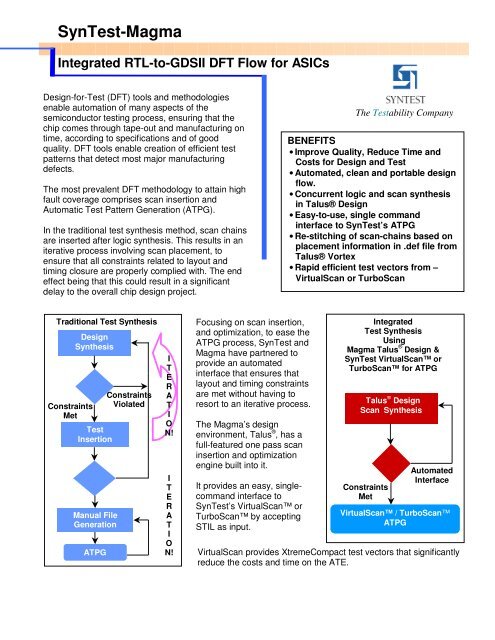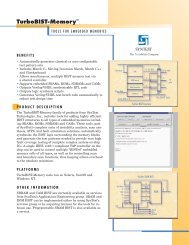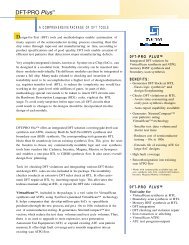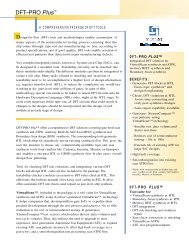SynTest-Magma
SynTest-Magma
SynTest-Magma
Create successful ePaper yourself
Turn your PDF publications into a flip-book with our unique Google optimized e-Paper software.
<strong>SynTest</strong>-<strong>Magma</strong><br />
Integrated RTL-to-GDSII DFT Flow for ASICs<br />
Design-for-Test (DFT) tools and methodologies<br />
enable automation of many aspects of the<br />
semiconductor testing process, ensuring that the<br />
chip comes through tape-out and manufacturing on<br />
time, according to specifications and of good<br />
quality. DFT tools enable creation of efficient test<br />
patterns that detect most major manufacturing<br />
defects.<br />
The most prevalent DFT methodology to attain high<br />
fault coverage comprises scan insertion and<br />
Automatic Test Pattern Generation (ATPG).<br />
In the traditional test synthesis method, scan chains<br />
are inserted after logic synthesis. This results in an<br />
iterative process involving scan placement, to<br />
ensure that all constraints related to layout and<br />
timing closure are properly complied with. The end<br />
effect being that this could result in a significant<br />
delay to the overall chip design project.<br />
The Testability Company<br />
BENEFITS<br />
• Improve Quality, Reduce Time and<br />
Costs for Design and Test<br />
• Automated, clean and portable design<br />
flow.<br />
• Concurrent logic and scan synthesis<br />
in Talus® Design<br />
• Easy-to-use, single command<br />
interface to <strong>SynTest</strong>’s ATPG<br />
• Re-stitching of scan-chains based on<br />
placement information in .def file from<br />
Talus® Vortex<br />
• Rapid efficient test vectors from –<br />
VirtualScan or TurboScan<br />
Traditional Test Synthesis<br />
Constraints<br />
Met<br />
Design<br />
Synthesis<br />
Test<br />
Insertion<br />
Manual File<br />
Generation<br />
ATPG<br />
Constraints<br />
Violated<br />
I<br />
T<br />
E<br />
R<br />
A<br />
T<br />
I<br />
O<br />
N!<br />
I<br />
T<br />
E<br />
R<br />
A<br />
T<br />
I<br />
O<br />
N!<br />
Focusing on scan insertion,<br />
and optimization, to ease the<br />
ATPG process, <strong>SynTest</strong> and<br />
<strong>Magma</strong> have partnered to<br />
provide an automated<br />
interface that ensures that<br />
layout and timing constraints<br />
are met without having to<br />
resort to an iterative process.<br />
The <strong>Magma</strong>’s design<br />
environment, Talus ® , has a<br />
full-featured one pass scan<br />
insertion and optimization<br />
engine built into it.<br />
It provides an easy, singlecommand<br />
interface to<br />
<strong>SynTest</strong>’s VirtualScan or<br />
TurboScan by accepting<br />
STIL as input.<br />
Integrated<br />
Test Synthesis<br />
Using<br />
<strong>Magma</strong> Talus ® Design &<br />
<strong>SynTest</strong> VirtualScan or<br />
TurboScan for ATPG<br />
Talus ® Design<br />
Scan Synthesis<br />
Constraints<br />
Met<br />
Automated<br />
Interface<br />
VirtualScan / TurboScan<br />
ATPG<br />
VirtualScan provides XtremeCompact test vectors that significantly<br />
reduce the costs and time on the ATE.
Integrated DFT and Synthesis Solution for ASICs<br />
<strong>SynTest</strong>'s DFT-PRO Plus DFT tool set, tightly ties<br />
with <strong>Magma</strong>’s verification, synthesis and layout<br />
products to provide customers with a complete ‘RTL<br />
to GDSII’ solution and a smooth product design flow.<br />
DFT-PRO Plus offers an integrated DFT solution<br />
covering scan synthesis and ATPG, memory BIST<br />
synthesis and boundary-scan (JTAG) synthesis. The<br />
corresponding tools generate RTL blocks that fit<br />
seamlessly into an existing synthesis flow.<br />
The block diagram alongside<br />
shows the integrated DFT and<br />
Synthesis Solution for ASICs, that<br />
enables <strong>Magma</strong> customers who<br />
use the Talus ® Design<br />
environment for logic synthesis,<br />
in conjunction with <strong>Magma</strong>'s<br />
Talus ® Vortex Placement and<br />
Routing environment, to perform<br />
automatic insertion of scan<br />
chains, followed by compact, high<br />
fault coverage ATPG, in one<br />
pass.<br />
<strong>SynTest</strong> DFT-PRO Plus<br />
RTL Scan<br />
Synthesis<br />
VirtualScan<br />
BENEFITS<br />
• Improves Quality & Reduces Time and Costs<br />
for ASIC Design and Test.<br />
• DFT structures at the RTL allow designers<br />
do quick “what-if” analysis and their impact<br />
on area, timing, power, etc., is more<br />
predictable.<br />
• Checks and fixes DFT rules violations at the<br />
RTL to avoid expensive iterations.<br />
• Integrates <strong>Magma</strong> Talus® simulation<br />
environment with <strong>SynTest</strong>’s DFT-PRO<br />
Plus, which includes VirtualScan, to<br />
save ATE and test costs.<br />
Memory BIST<br />
TurboBIST-<br />
Memory<br />
Boundary Scan<br />
Synthesis<br />
TurboBSD<br />
Design<br />
Info<br />
The diagram depicts a<br />
comprehensive flow for insertion<br />
of DFT technology into a typical<br />
ASIC design, covering<br />
scan/ATPG, memory BIST and<br />
boundary-scan synthesis, as well<br />
as checking for DFT rule<br />
violations at both RTL and gatelevel<br />
stages of an ASIC design.<br />
Automatic<br />
DFT Repair<br />
DFT Integration and Stitching<br />
TurboDFT<br />
Integrated RTL<br />
DFT Check at RTL<br />
TurboCheck-RTL<br />
RTL<br />
Design<br />
Verilog<br />
RTL<br />
Blocks<br />
Testable RTL<br />
Functional<br />
Verification using<br />
Verilog<br />
The DFT tools generate DFT<br />
blocks at RTL that fit seamlessly<br />
into an existing synthesis flow<br />
and also ease the design floor<br />
planning process.<br />
Further checking DFT violations<br />
at RTL averts costly and timeconsuming<br />
post-synthesis<br />
surprises.<br />
DFT Check at Gate-level<br />
TurboCheck-Gate<br />
Scan Synthesis &<br />
Automatic Test Pattern<br />
Generation (ATPG)<br />
VirtualScan<br />
TP-out<br />
Gatelevel<br />
Logic Synthesis<br />
using Talus®<br />
Gate-level Netlist<br />
Verification of<br />
ATPG patterns<br />
using Verilog<br />
<strong>Magma</strong><br />
Individual applications of <strong>SynTest</strong><br />
and <strong>Magma</strong> interfaces are<br />
described below.<br />
ATE supported:<br />
Advantest, Verigy,<br />
LTX-Credence,<br />
Teradyne, Teseda<br />
Manufacturing<br />
Test Patterns<br />
Outputs for postprocessing:<br />
Verilog– serial/parallel;<br />
WGL, STIL
Application:<br />
Functional verification of testable RTL<br />
<strong>Magma</strong> Interface: Verilog simulation<br />
environment, as a part of <strong>Magma</strong> Talus®<br />
<strong>SynTest</strong> Interface: TurboCheck-RTL<br />
<strong>SynTest</strong> DFT-PRO Plus<br />
RTL Scan<br />
Synthesis<br />
VirtualScan<br />
Memory BIST<br />
TurboBIST-<br />
Memory<br />
Boundary<br />
Scan<br />
Synthesis<br />
Design Info<br />
The DFT blocks generated at the RTL by<br />
the various <strong>SynTest</strong> DFT tools and the<br />
design RTL blocks are automatically<br />
stitched together by <strong>SynTest</strong>’s TurboDFT<br />
to generate an Integrated RTL.<br />
Before being fed as a testable RTL, via a<br />
<strong>Magma</strong> Talus® design platform interface<br />
for functional verification, the Integrated<br />
RTL is fed to <strong>SynTest</strong>’s TurboCheck-RTL<br />
to check for DFT rule violations.<br />
Automatic<br />
DFT Repair<br />
DFT Integration and Stitching<br />
TurboDFT<br />
Integrated RTL<br />
DFT Check at RTL<br />
TurboCheck-RTL<br />
RTL<br />
Design<br />
Verilog<br />
RTL Blocks<br />
Testable RTL<br />
Application: Functional verification of testable RTL<br />
Functional<br />
Verification using<br />
Verilog<br />
Designers can very quickly identify testability problems at the earliest stages of the design cycle, even<br />
before the often time-consuming logic synthesis process. TurboCheck-RTL can also be used to identify<br />
design coding errors and synthesis constraint violations. TurboCheck tools find many testability problems<br />
quickly and automatically, including floating nets, busses and ports, combinational feedback loops,<br />
uncontrollable or unobservable nodes, potential bus contention, combinationally gated clocks, and<br />
sequentially generated/gated clocks and asynchronous set/reset conditions.<br />
Application:<br />
Logic synthesis of testable RTL<br />
<strong>SynTest</strong> DFT-PRO Plus<br />
<strong>Magma</strong> Interface: Talus® Design<br />
<strong>SynTest</strong> Interface: TurboCheck-RTL and<br />
TurboCheck-Gate<br />
The testable RTL is fed to Talus® for<br />
logic synthesis. Talus® generates a gatelevel<br />
netlist that is used for scan synthesis<br />
and ATPG. Outputs from Talus® are also<br />
fed to other <strong>Magma</strong> tools for Placement<br />
and routing.<br />
Designers can perform a structural level<br />
check on the final synthesized design,<br />
using TurboCheck-Gate, to further identify<br />
and zero-in on any final testability<br />
violations that could not be detected at<br />
the RTL.<br />
Integrated RTL<br />
DFT Check at RTL<br />
TurboCheck-RTL<br />
DFT Check at Gate-level<br />
TurboCheck-Gate<br />
Scan Synthesis &<br />
Automatic Test Pattern<br />
Generation (ATPG)<br />
VirtualScan<br />
Testable RTL<br />
Logic Synthesis<br />
using Talus®<br />
TurboCheck tools compute and report controllability and observability values according to the structure of<br />
the design and identify most common - and not so common - testability issues that could prevent efficient<br />
ATPG and fault simulation. TurboCheck also offers automatic insertion of test points using any external<br />
scan selection algorithm and analyses the effect of the selection on the testability of the circuit.<br />
TurboCheck tools find many testability problems quickly and automatically, including floating nets, busses<br />
and ports, combinational feedback loops, uncontrollable or unobservable nodes, potential bus contention,<br />
combinationally gated clocks, and sequentially generated/gated clocks and asynchronous set/reset<br />
conditions.<br />
RTL<br />
Gatelevel<br />
Application: Logic synthesis of testable RTL<br />
Gate-level Netlist
Application:<br />
Functional verification of ATPG patterns<br />
<strong>Magma</strong> Interface: <strong>Magma</strong> Talus® Verilog<br />
interface.<br />
<strong>SynTest</strong> Interface: VirtualScan<br />
VirtualScan is a tool for scan insertion<br />
and ATPG with test compression capability<br />
to generate XtremeCompact scan test<br />
patterns. This reduces the scan test cost by<br />
a factor of 5x to 100x through reduced test<br />
data volume, test application time and ATE<br />
reloads.<br />
These ATPG test patterns are fed via the<br />
<strong>Magma</strong> Verilog interface to its Talus® for<br />
functional verification.<br />
<strong>SynTest</strong> DFT-PRO Plus<br />
DFT Check at Gate-level<br />
TurboCheck-Gate<br />
ATE supported:<br />
Advantest, Verigy,<br />
LTX-Credence,<br />
Teradyne, Teseda<br />
Scan Synthesis &<br />
Automatic Test Pattern<br />
Generation (ATPG)<br />
VirtualScan<br />
TP-out<br />
Manufacturing<br />
Test Patterns<br />
Gatelevel<br />
Outputs for postprocessing:<br />
Verilog–serial/parallel,<br />
WGL, STIL<br />
Gate-level Netlist<br />
Verification of<br />
ATPG patterns<br />
using Verilog<br />
They are also fed via TP-out, as<br />
testbenches and manufacturing test<br />
patterns, and are available in a variety of<br />
formats.<br />
Application:<br />
Physical synthesis and integration of<br />
Logic BIST blocks<br />
Application: Functional verification of ATPG patterns<br />
Talus ® Design<br />
Scan Synthesis<br />
<strong>Magma</strong> Interface: Talus® Vortex<br />
<strong>SynTest</strong> Interface: TurboBIST-Logic<br />
Talus® Design provides a gate-level<br />
netlist. Based on it, TurboBIST-Logic<br />
generates logic BIST blocks consisting of<br />
a central BIST controller and needed<br />
Pseudo-Random Pattern Generators<br />
(PRPGs) and Multiple-Input Signature<br />
Registers (MISRs). These are fed to<br />
Talus® Design for BIST block synthesis,<br />
and subsequently to Talus® Vortex for<br />
placement and routing.<br />
Constraints<br />
Met<br />
TurboBIST-Logic<br />
Talus ® Design<br />
BIST Block Synthesis<br />
Talus®<br />
Vortex<br />
Layout & Timing<br />
Closure<br />
Automated<br />
Interface<br />
Application: Physical synthesis and integration of<br />
Logic-BIST blocks<br />
<strong>SynTest</strong> Technologies, Inc.<br />
www.syntest.com<br />
505 S. Pastoria Ave, Suite 101, Sunnyvale, CA 94086 info@syntest.com<br />
Tel: 408-720-9956 Fax: 408-720-9960









